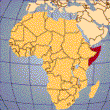|
 Somalis
speak Somali. Many people also speak Arabic, and educated
Somalis usually speak either English or Italian as well. Swahili
may also be spoken in coastal areas near Kenya. Somali is
a member of a group of languages called lowland Eastern Cushitic.
Eastern Cushitic, spoken by people living in Ethiopia, Eritrea,
Somalia, Djibouti, Kenya, and Sudan, belongs to the Cushitic
language family, which in turn is part of the Afro-Asiatic
stock. Somali has two major dialects: the standard dialect,
spoken by most Somalis, and the Digil/Raxanweyn dialect, spoken
primarily in the interriverine areas of the south. Somalis
speak Somali. Many people also speak Arabic, and educated
Somalis usually speak either English or Italian as well. Swahili
may also be spoken in coastal areas near Kenya. Somali is
a member of a group of languages called lowland Eastern Cushitic.
Eastern Cushitic, spoken by people living in Ethiopia, Eritrea,
Somalia, Djibouti, Kenya, and Sudan, belongs to the Cushitic
language family, which in turn is part of the Afro-Asiatic
stock. Somali has two major dialects: the standard dialect,
spoken by most Somalis, and the Digil/Raxanweyn dialect, spoken
primarily in the interriverine areas of the south.
 Although
the Digil/Raxanweyn dialect in the south is almost as different
from standard Somali as French is from Italian, most Digil/Raxanweyn
speakers are familiar with standard Somali. Thus, language
provides a channel of communication for people thousands of
miles apart. Somali has adopted many Arabic words, both modern
phrases to deal with modern institutions, such as government
and finance, and older Arabic terms to discuss international
trade and religion. Somali also contains old Qahtani words
common to Cushitic and Semitic languages. Although
the Digil/Raxanweyn dialect in the south is almost as different
from standard Somali as French is from Italian, most Digil/Raxanweyn
speakers are familiar with standard Somali. Thus, language
provides a channel of communication for people thousands of
miles apart. Somali has adopted many Arabic words, both modern
phrases to deal with modern institutions, such as government
and finance, and older Arabic terms to discuss international
trade and religion. Somali also contains old Qahtani words
common to Cushitic and Semitic languages.
 Somali
had no written form until 1972, when a Somali script, based
on the Roman alphabet, was adopted. Until that time, English
and Italian served as the languages of government and education.
This served to create an elite, since only a small proportion
of Somali society who knew these colonial languages had access
to government positions or the few managerial or technical
jobs in private enterprise. The 1972 decision to introduce
a Somali script fundamentally changed the situation. Somali
officials were required to learn the script, and a countrywide
literacy campaign was launched. Great progress was made in
the development of national literacy, particularly in the
rural areas, where previous literacy campaigns had failed.
In 1975, government figures indicated a literacy rate of 55%,
in contrast to a 5% rate before the adoption of the national
script. Even if the government estimate is exaggerateda 1990
U.N. estimate put the national literacy rate at 24%Somali
progress in literacy has clearly been significant. Somali
had no written form until 1972, when a Somali script, based
on the Roman alphabet, was adopted. Until that time, English
and Italian served as the languages of government and education.
This served to create an elite, since only a small proportion
of Somali society who knew these colonial languages had access
to government positions or the few managerial or technical
jobs in private enterprise. The 1972 decision to introduce
a Somali script fundamentally changed the situation. Somali
officials were required to learn the script, and a countrywide
literacy campaign was launched. Great progress was made in
the development of national literacy, particularly in the
rural areas, where previous literacy campaigns had failed.
In 1975, government figures indicated a literacy rate of 55%,
in contrast to a 5% rate before the adoption of the national
script. Even if the government estimate is exaggerateda 1990
U.N. estimate put the national literacy rate at 24%Somali
progress in literacy has clearly been significant.
|

 The Somali Language and Literacy.
The Somali Language and Literacy.